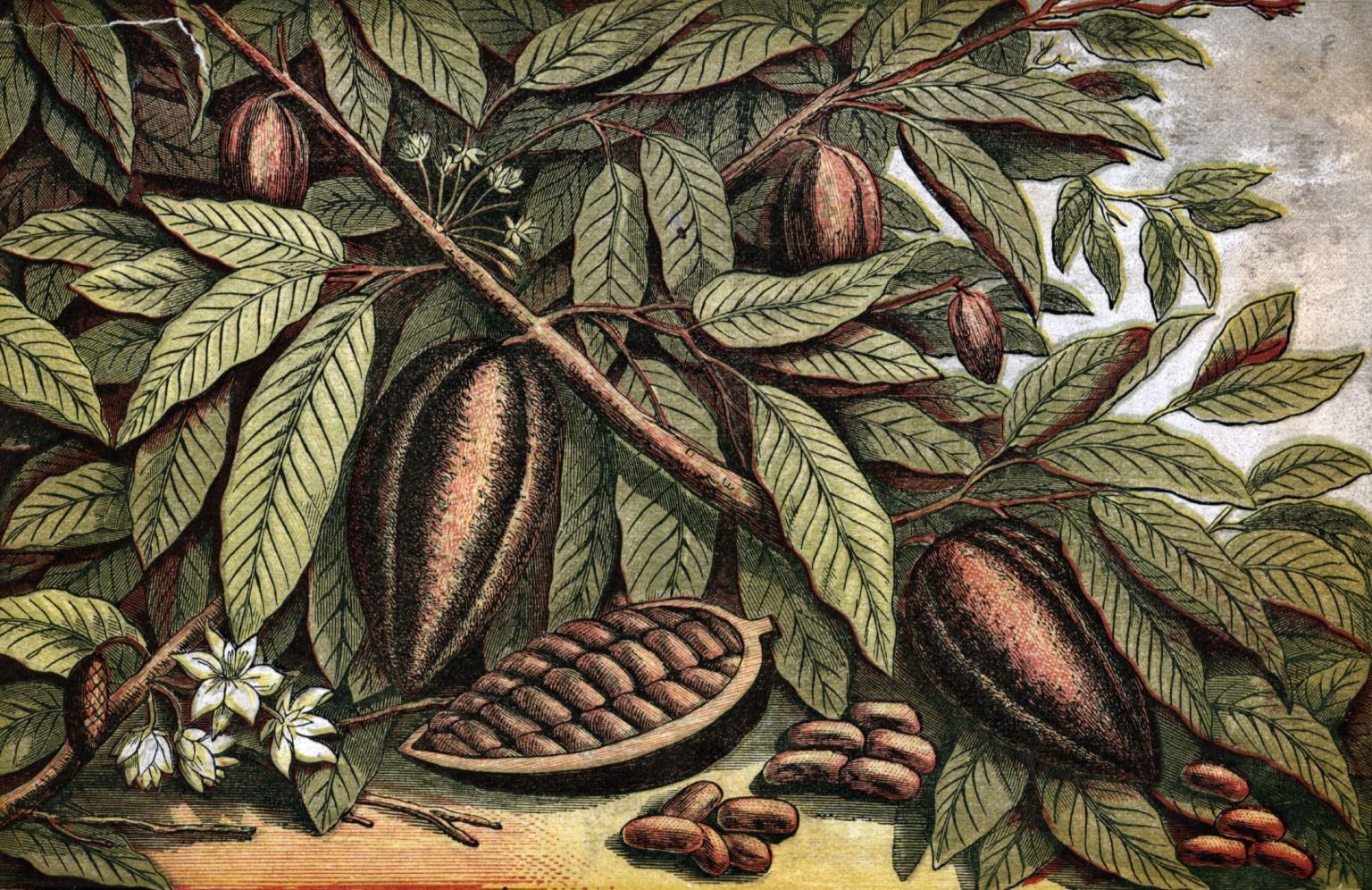
In the first two editions of the “Lab Report”, we learned how certain chemicals in ceremonial cacao help support our energy levels and cardiovascular health. But what about our mood? Much has been made of the emotional elements of cacao consumption–reports of elation and heightened wellbeing abound. What might be the chemical components of these phenomena? Let’s explore cacao’s mental magic in this part III of the Lab Report.

The long journey up top: tryptophan in ceremonial cacao
As we move from the cardiovascular complex to the head, we must detour through the gut. It is here where the majority–up to 95%–of one of our most important behavioral chemicals, serotonin (5-ht), is produced. Serotonin is vital for myriad mental and physical processes including sleep, digestion, and concentration. However, its foremost role with respect to cacao is in mood regulation. In a stressful and often depressing world, healthy serotonin regulation is paramount.
While we cannot get serotonin directly from food, cacao is rich in a more fundamental building block of serotonin: L-tryptophan (trp). As an essential amino acid, tryptophan is vital to protein synthesis within the body, but it is also central to two other metabolic pathways: the aforementioned serotonin and kynurenine (kyn).
Kynurenine helps to modulate our inflammatory and stress responses, among other things. In fact, it is glucocorticoids (stress hormones) and pro-inflammatory cytokines (immune response signals) that facilitate the breakdown of trp into the kyn pathway. Around 95% of ingested trp is typically diverted to the kyn pathway, but the 5% used to synthesize 5-ht is incredibly important. Even less of the available trp passes through to the brain, as most of the trp used for 5-ht synthesis remains in the gut .
These two pathways compete for available tryptophan to complete their processes. Excess tryptophan metabolism via the kyn pathway has been linked to chronic inflammation and neurological diseases such as major depression, schizophrenia, Alzheimer’s. It has been hypothesized that a reduced trp/kyn ratio can be partly responsible for disorders of serotonin deficiency such as depression. And since increase of trp diverted to the kyn pathway occurs under conditions of chronic stress and inflammation, it is then the conditions of chronic disease that are responsible for lowered 5-ht synthesis, and thus low mood. Plainly, the theory goes that bodily inflammatory response (whether due to sickness, poor diet, or environmental factors) can quite literally make you depressed. Conversely, the breakdown of tryptophan into serotonin as well as the sleep-regulating hormone melatonin can be partially thanked for feelings of calm or happiness.
Now, where does cacao come into play? In addition to being a strong source of the tryptophan building block for these processes which help create serotonin and melatonin, cacao can help alleviate the inflammatory pressures that divert trp away from the 5-ht pathway and toward the kyn pathway. If you read the Lab Report part II, you may recall our discussion of cacao flavanols and their antioxidant, anti-inflammatory action. As one of nature’s most potent antioxidants (if not the most potent), whole cacao helps suppress the pro-inflammatory responses of the immune system and keep the body from chronic stress. In the absence of this stress/inflammatory pressure, the trp/kyn balance can benefit the production of 5-ht, resulting in improved mood.
The bottom line is that, when used as part of a wellness regimen that includes stress-reduction techniques and immune-supportive exercise, cacao can be a powerful ally in our daily happiness.
Now let’s explore the important chemicals that we find in lower concentrations in Cacao. Particularly, two molecules that have psychoactive effects which can be a vital part of mood support: phenylethylamine (PEA) and anandamide.

For the love of cacao: PEA on the brain
The so-called “love drug”, phenylethylamine (PEA) in cacao is actually a byproduct of the roasting process. When concentrations are increased in the human brain, neurotransmitters such as dopamine and norepinephrine are stimulated, and we can feel overwhelming positive emotion. It is believed that heightened PEA concentrations in the brain are central to falling in love, and one of PEA’s primary metabolites, phenylacetic acid, has been linked to the phenomenon known as the “runner’s high”.
PEA has also been shown to improve mood and concentration in subjects with both depressive disorder and ADHD symptoms. It has been hypothesized that it is PEA that is responsible for the infamous chocolate craving, but evidence of this is inconclusive.
In the brain, PEA works to inhibit the reuptake of the neurotransmitters serotonin, dopamine, and norepinephrine by altering their synaptic transport function. Over a period of time, these neurotransmitters build up at the synapses and we feel mood elevation. Dopamine and serotonin uptake blockers such as amphetamines, anti-depressant SSRIs, and ADHD medications such as Ritalin function similarly. Plant medicine experts have it that cacao can be vital to replicating the positive benefits of these drugs without having to rely on pharmaceuticals.
Endocannabinoids and cacao: anandamide in action
Anandamide (AEA), the so-called “bliss molecule”, is one of the only two endocannabinoids (cannabinoids produced by the body itself) yet identified by scientists, the other being 2-arachidonolyglycerol (2-AG). These endocannabinoids are often thought of as working within a “lock and key” system with cannabinoid receptors all around the body, which are generally classified into the CB1 type–clustered tightly in the brain and nervous system, among other organ tissues–and the CB2 type–found throughout the body but most closely associated with the immune and digestive systems. Within the popular context of marijuana, you could consider CB1 to be psychoactive receptors that are acted upon by THC for the characteristic “high”, and CB2 to be largely immunomodulatory receptors that have not been shown to be psychoactive.
While its possible that cacao itself contains anandamide, the concentrations exhibited in study have been low–low enough to be negligible. Cacao, however, contains two other chemical components important to the endocannabinoid system: the N-acylethanolamines known as oleoylethanolamide (OEA) and linoleoylethanolamide (LEA). The action by which these endocannabinoid analogs work within the endocannabinoid system remains unclear, but one thing is for sure: either by acting upon the cannabinoid receptors directly or by inhibiting the breakdown of endogenous anandamide, these molecules work to heighten and prolong positive cannabinoid response in the brain and body.

Make it a ritual: daily mental wellness support with ceremonial cacao
Pure ceremonial-grade cacao has been used over the centuries to facilitate togetherness and self-discovery. In the modern day, we can continue to explore these uses, but with a contemporary understanding of the chemical processes at play. As we can see, cacao can support our mental wellbeing through a few different pathways, not the least of which is the intangible mental benefit of daily ritual. Along with the uplifting circulatory effects of theobromine, the chemicals outlined here work to help us maintain higher levels of our own feel-good chemicals–and for longer. With habitual use, pure cacao can become one of our great allies on our path to fulfillment and true mental wellness.
